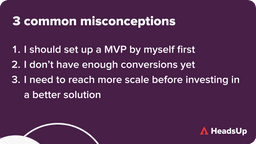Speaking to GTM leaders, many have asked us – when is the right time to use a full-fledged tool like HeadsUp? Should we start off by first building an MVP ourselves?
Actually, adopting a PQL platform is like investing your money in ETFs – most people start too late.
Companies that set up a fully-functional system avoid a lot of pain down the road. They also see better performance across their funnel from the get go.
Why is that? We’ll explain while also tackling some of the myths holding teams back from adopting a PQL platform.
Here are 3 common misconceptions that lead to people thinking they are ‘too early’ for a platform and our responses:
1. “I first want to experiment with a few simple PQL definitions. My intuitive understanding of what signals to look out for should suffice for this – I don’t need a tool.”
HeadsUp is built to help teams experiment with PQLs. It’s a tool to ideate and test your hypotheses. Cut out the back-and-forth with data teams, and you’ll be able to set up PQL experiments in minutes instead of weeks!
We offer an end-to-end solution: Our algorithms can suggest signals to look out for based on your historical conversation. Then, you can combine these with other attributes you care about, such as size of company, job titles etc.
You can group each PQL into a user segment, and target that segment with sales or marketing outreach, by triggering actions in other tools such CRMs or marketing automation software.
Finally, we provide a dashboard to help compare the effectiveness of each of your experiments. At one glance, you can spot which PQL definition works best, and what kind of sales or marketing channels generate the most conversions for that PQL.
2. “I have too few leads and conversions right now. I’m not sure a tool will be able to help us analyze the data, since there’s so little of it.”
After working with 20+ companies, we’ve found that we are able to suggest meaningful signals for your PQL definition based on as long as you have 100 historical conversions.
Furthermore, our data engineering team can hoover up data stored in your warehouse or any tool that allows for an export, so most companies have way more data than they realize.
Finally, HeadsUp is not just built to identify PQL signals. Many early-stage startups use it to provide their GTM teams more visibility into product usage. Sales teams love looking at how their top accounts are using their product, to come up with a specially-tailored demo.
3. “We’ll only want to spend on a tool when we have sufficient scale. It’s not economical when we can do things that don’t scale right now.”
Migrating a CRM is a pain when you are processing thousands of leads. Trying to move over to a new PQL solution after using one for a few years would be even more painful. It’ll come with a lot of risk and downtime, which you can mitigate by sticking to the same solution.
In both money and time, the cost of developing an internal solution is much greater than you think. One growth leader we spoke to spent 6 months managing an internal team of product and engineering resources, trying to get the initiative off the ground.
“It’s just hard to fully dedicate engineers to this, when they have the core product to work on. Plus it’s a lot more work than we thought – from making a UI, building integrations, to training an analytics model”, they griped to us. Eventually, they tried out HeadsUp, and they ran their first PQL experiment within 2 weeks!
Given the tech downturn, improving GTM efficiency is more important than ever. HeadsUp helps GTM leaders deliver impact fast, without depending on technical teams. “Using a solution like HeadsUp helped us crawl, walk, and run. You don’t have to figure everything out on your own.” a VP of Sales we are working with suggested.
See what HeadsUp can do for you here!



